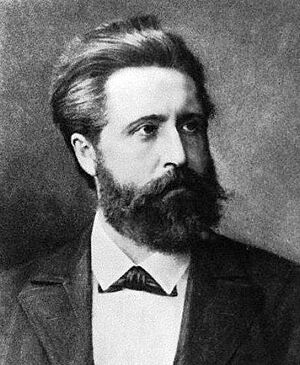Philipp Scharwenka facts for kids
Quick facts for kids
Ludwig Philipp Scharwenka
|
|
|---|---|

L. P. Scharwenka
|
|
| Background information | |
| Born | 16 February 1847 Samter, Prussia |
| Died | 16 July 1917 (aged 70) Bad Nauheim, Germany |
| Genres | Classical |
| Occupation(s) | Pianist, composer |
| Instruments | Piano |
Ludwig Philipp Scharwenka was a talented Polish-German composer and music teacher. He was born on February 16, 1847, in Szamotuły, which was then part of Prussia. He passed away on July 16, 1917, in Bad Nauheim, Germany. Philipp was the older brother of another famous composer, Xaver Scharwenka.
Contents
Becoming a Musician
Philipp Scharwenka was born in Szamotuły. Like his younger brother Xaver, he started learning music in Poznań. After finishing college in 1865, he moved to Berlin.
In Berlin, he studied music theory with famous teachers like Richard Wüerst and Heinrich Dorn. He attended the new Musical Academy. By 1868, he became a teacher there himself, teaching music theory and how to compose. During this time, he also started writing his own music. In 1874, he held his first concert, where he showed off an overture and a symphony.
Amazing Compositions
Even with many teaching duties, Philipp Scharwenka was a very important composer. People recognized his talent during his lifetime. He wrote many different types of music.
His works include:
- Three Symphonies (large pieces for orchestra).
- Symphonic Poems (music that tells a story or describes a scene).
- A Violin Concerto (a piece for violin and orchestra).
- Choral works (music for choirs), like Sakuntala, which became very well-known.
- An opera called Roland.
- Many pieces for instruments, such as Sonatas, Quartets, Caprices, and Dances.
Many famous conductors, like Arthur Nikisch and Hans Richter, performed his orchestral music. He is still known for his chamber music. This includes pieces for small groups of instruments, like piano trios, violin sonatas, and string quartets.
Philipp's music was often described as dreamy and moody. This was different from his brother Xaver's more outgoing style. His chamber music, especially from 1896 onwards, was very popular. He used traditional forms but filled them with new melodies and rhythms. He even created sounds that were almost like impressionist paintings, using clever musical techniques. Famous musicians like Willy Burmester played his works.
A well-known composer named Max Reger admired Philipp's music. In 1898, Reger dedicated his Phantasiestücke (Fantasy Pieces) to Philipp. In 1900, Philipp's Dramatic Fantasy for Orchestra won a prize. It was performed at a big music congress in Bremen.
Leading a Music School
In 1881, Philipp's brother Xaver opened the Scharwenka-Conservatory in Berlin. Xaver asked Philipp to lead the teaching of theory and composition there. Later, in 1891, Philipp also took charge of a sister-conservatory in New York.
However, Philipp returned to Berlin in 1892. He took over the main Conservatory there. In 1893, he combined it with the Piano School of Karl Klindworth. This new school became the Klindworth-Scharwenka Conservatory. It grew into a very important music school in Berlin. Philipp remained the director until he passed away in 1917. Famous musicians like Otto Klemperer and Oskar Fried studied with him. See: List of music students by teacher: R to S#Philipp Scharwenka.
Family and Other Talents
In 1880, Philipp married Marianne Scharwenka, a talented violin player. She passed away in 1918. Their son, Walter Scharwenka, later became the director of the Conservatory in 1937.
Philipp was also a skilled artist. He drew funny and lively pictures. For example, he created illustrations for a book called Anton Notenquetscher by Alexander Moszkowski.
Selected Works
Philipp Scharwenka wrote many pieces of music. Here are some examples of the types of works he created:
Symphonies
- Symphony No. 1, Herbstfeier (Autumn Celebration)
- Symphony No. 2 in D minor
- Symphony No. 3, Sinfonia Brevis (Short Symphony)
Orchestral Music
- Serenade for Orchestra
- Wald- & Berggeister (Forest and Mountain Sprites)
- Liebesnacht (Love Night), a fantasy piece
- Fest-Ouvertüre (Festive Overture)
- Arkadische Suite (Arcadian Suite)
- Frühlingswogen (Spring Waves)
- Dramatische Phantasie (Dramatic Fantasy)
Concertos
- Violin Concerto in G major
Chamber Music
- Piano Trios (for piano, violin, and cello)
- Violin Sonatas (for violin and piano)
- Viola Sonata (for viola and piano)
- Cello Sonata (for cello and piano)
- String Quartets (for two violins, viola, and cello)
- Piano Quintet (for piano and string quartet)
Vocal Music
- Sakuntala for choir and orchestra
- Many songs for voice and piano
- Pieces for choir without instruments (a capella)
Piano Music
- Polish Dances
- Capriccietto (a small caprice)
- Phantasiestück (Fantasy Piece)
- Nocturnes (night pieces)
- Albumblätter (Album Leaves)
- Mazurkas (Polish folk dances)
- Aus der Jugendzeit (From Youth), easy piano pieces
- Piano Sonatas
- Kinderspiele (Children's Games), easy piano pieces
- Abendstimmungen (Evening Moods)

